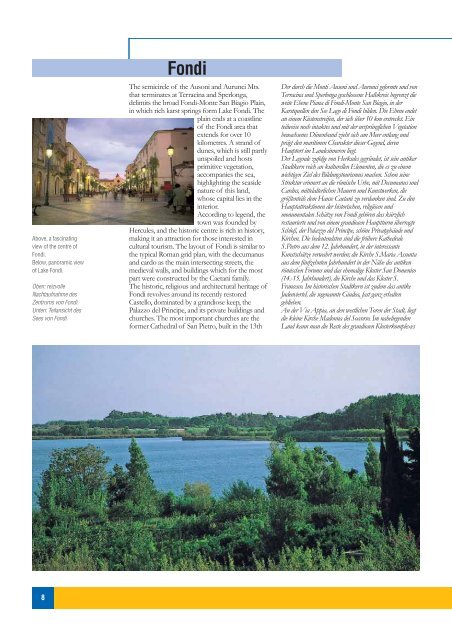Create successful ePaper yourself
Turn your PDF publications into a flip-book with our unique Google optimized e-Paper software.
Above, a fascinating<br />
view of the centre of<br />
Fondi.<br />
Below, panoramic view<br />
of Lake Fondi.<br />
Oben: reizvolle<br />
Nachtaufnahme des<br />
Zentrums von Fondi.<br />
Unten: Teilansicht des<br />
Sees von Fondi.<br />
Fondi<br />
The semicircle of the Ausoni and Aurunci Mts.<br />
that terminates at Terracina and Sperlonga,<br />
delimits the broad Fondi-Monte San Biagio Plain,<br />
in which rich karst springs form Lake Fondi. The<br />
plain ends at a coastline<br />
of the Fondi area that<br />
extends for over 10<br />
kilometres. A strand of<br />
dunes, which is still partly<br />
unspoiled and hosts<br />
primitive vegetation,<br />
accompanies the sea,<br />
highlighting the seaside<br />
nature of this land,<br />
whose capital lies in the<br />
interior.<br />
According to legend, the<br />
town was founded by<br />
Hercules, and the historic centre is rich in history,<br />
making it an attraction for those interested in<br />
cultural tourism. The layout of Fondi is similar to<br />
the typical Roman grid plan, with the decumanus<br />
and cardo as the main intersecting streets, the<br />
medieval walls, and buildings which for the most<br />
part were constructed by the Caetani family.<br />
The historic, religious and architectural heritage of<br />
Fondi revolves around its recently restored<br />
Castello, dominated by a grandiose keep, the<br />
Palazzo del Principe, and its private buildings and<br />
churches. The most important churches are the<br />
former Cathedral of San Pietro, built in the 13th<br />
Der durch die Monti Ausoni und Aurunci geformte und von<br />
Terracina und Sperlonga geschlossene Halbkreis begrenzt die<br />
weite Ebene Piana di Fondi-Monte San Biagio, in der<br />
Karstquellen den See Lago di Fondi bilden. Die Ebene endet<br />
an einem Küstenstreifen, der sich über 10 km erstreckt. Ein<br />
teilweise noch intaktes und mit der ursprünglichen Vegetation<br />
bewachsenes Dünenband zieht sich am <strong>Meer</strong> entlang und<br />
prägt den maritimen Charakter dieser Gegend, deren<br />
Hauptort im Landesinneren liegt.<br />
Der Legende zufolge von Herkules gegründet, ist sein antiker<br />
Stadtkern reich an kulturellen Elementen, die es zu einem<br />
wichtigen Ziel des Bildungstourismus machen. Schon seine<br />
Struktur erinnert an die römische Urbe, mit Decumanus und<br />
Cardus, mittelalterlichen Mauern und Kunstwerken, die<br />
größtenteils dem Hause Caetani zu verdanken sind. Zu den<br />
Hauptattraktionen der historischen, religiösen und<br />
monumentalen Schätze von Fondi gehören <strong>das</strong> kürzlich<br />
restaurierte und von einem grandiosen Hauptturm überragte<br />
Schloß, der Palazzo del Principe, schöne Privatgebäude und<br />
Kirchen. Die bedeutendsten sind die frühere Kathedrale<br />
S.Pietro aus dem 12. Jahrhundert, in der interessante<br />
Kunstschätze verwahrt werden; die Kirche S.Maria Assunta<br />
aus dem fünfzehnten Jahrhundert in der Nähe des antiken<br />
römischen Forums und <strong>das</strong> ehemalige Kloster San Domenico<br />
(14.-15. Jahrhundert), die Kirche und <strong>das</strong> Kloster S.<br />
Francesco. Im historischen Stadtkern ist zudem <strong>das</strong> antike<br />
Judenviertel, die sogenannte Giudea, fast ganz erhalten<br />
geblieben.<br />
An der Via Appia, an den westlichen Toren der Stadt, liegt<br />
die kleine Kirche Madonna del Soccorso. Im naheliegenden<br />
Land kann man die Reste des grandiosen Klosterkomplexes<br />
8

















